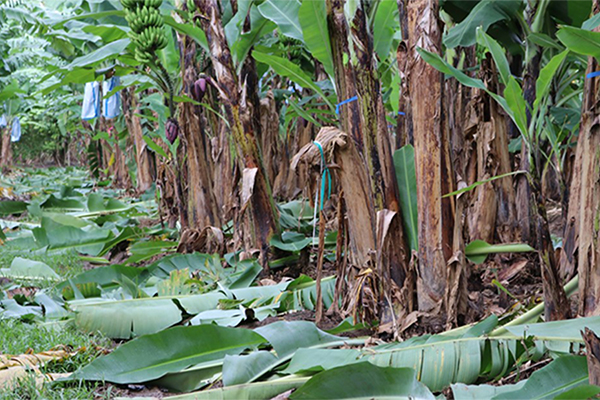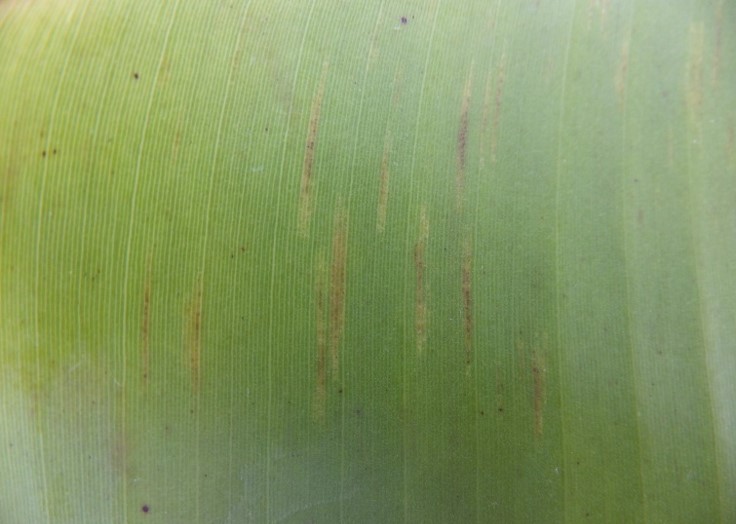Fungicides and options to manage the development of resistance
Fungicides help manage yellow Sigatoka in the tropics. We need to better manage their use or risk losing them forever.
Historical testing of yellow Sigatoka isolates in Far North Queensland has confirmed loss of sensitivity to strobilurin fungicides (e.g. Cabrio® and Flint®) and triazole fungicides1 (e.g. Folicur ®, Opus ® and Tilt ® are trade names).
There are relatively few new fungicides being registered, so it’s important to manage the usage of chemicals available today so they are effective in the future. Every grower needs to do their bit in protecting the industry. Here are several ways to manage fungicide resistance.
Deleaf spotted leaf, don't spray it!
The most critical part of managing Sigatoka disease in banana is deleafing (Figure 1). It can reduce ascospore production by up to 85%, significantly reducing the potential for disease resistance to develop on your farm and neighbouring farms.
Fungicides are not effective on visible necrotic spots and applying products to infected leaf material encourages fungicide resistance. Therefore, leaf spot infected leaves should be removed before fungicides are applied.
Deleafing is important all-year-round, however, spring is the key period. Ensure all spotted leaves are removed to reduce the level of disease prior to summer. Warm and wet summer conditions favour yellow Sigatoka developing, making it more difficult to manage.

Know the fungicide groups
Both protectant and systemic fungicides are available for managing yellow Sigatoka. Each chemical group has a different mode of action and has an important role to play in a spray program. This influences when these products should be used. A complete list of fungicide groups registered for managing yellow Sigatoka in the banana industry is in Table 1.
Protectant fungicides help prevent yellow Sigatoka developing and should form the bulk of your applications throughout the year. Mancozeb should always be applied with paraffinic oil, while chlorothalonil should never be applied with oil. Therefore, growers cannot alternate between mancozeb and chlorothalonil.
Systemic fungicides used in bananas are more accurately described as being ‘translaminar’, passing through the leaf tissue from one leaf surface to the other. This means the fungicide moves below the surface of the leaf but is not truly systemic because its movement is limited. The common misconception is that systemic fungicides used in bananas can ‘kill’ existing disease. While they are often referred to as ‘curatives’, their activity is limited to early stages (Figure 2) of the disease (Stages 1 to 2b). Once necrotic leaf spot symptoms are visible to the naked eye, fungicides will not arrest development. Fungicide application to lesion stages 3, 4 and 5 could encourage fungicide resistance to develop. Therefore, apply systemic fungicides when conditions are conducive to the disease developing in warm and wet weather conditions, and not when you can see symptoms.
Rotate fungicide groups
Chemicals, including fungicides, are grouped based on their mode of action and chemical structure.
There are nearly 200 trade names of fungicides registered to manage yellow Sigatoka in bananas. Know which groups the products belong to and ensure that systemic chemical groups are rotated.
It is important to rotate between the groups, not simply between products in these groups to avoid resistance. For example, switching between propiconazole and difenoconazole is not considered ‘rotating’ as both actives belong to Group 3.

Follow the product use recommendations
There are restrictions that apply, especially to the systemic fungicides, in relation to:
- maximum number of applications per year
- maximum number of consecutive sprays of the same fungicide group
- restricted ‘no spray’ periods when some fungicide groups are not permitted for use
Table 2 is based on CropLife Australia’s Fungicide Resistance Management Strategy for the Far North Queensland banana industry. This resistance strategy came into effect on 25 June 2015 and as product labels are renewed they will refer to this strategy.
Group 7 and Group 11 products must only be applied in a mixture with another fungicide from a different activity group, registered for control of yellow Sigatoka, at the full registered rate. Each fungicide included in the mixture counts towards the maximum number of spray applications allowed for Group 3 or Group 9 fungicides.
A resistance strategy is also available for areas outside of Far North Queensland. Refer to CropLife’s website for details.
Table 1 Fungicides currently registered in banana crops for management of yellow Sigatoka as of October 2023. Always check registration status and product label prior to use, through the APVMA website.

Use the recommended label rate
Thorough spray coverage
The application rates listed on the product label have been proven through field efficacy trials. Therefore, halving or increasing the rate of a fungicide product can encourage the development of a resistant population of the yellow Sigatoka organism.
Always check the label for the correct application rate, as different trade names may have varying amounts of an active ingredient. For example, the active ingredient propiconazole (Group 3) appears in more than 50 products registered for yellow Sigatoka management in bananas, and among this list are four different concentrations of the active ingredient.
For the fungicide to have the best chance at protecting the leaf from further infections, thorough spray coverage is required. This is especially important for the protectants which only work on the leaf area they come into direct contact with, and as already mentioned, the systemics have limited ability to move within the leaf.
Table 2 CropLife Australia’s fungicide resistance strategy for the Far North Queensland banana industry (Valid 14 July 2023).

Reference:
1. Grice, K. (2009) Assessment of yellow Sigatoka populations in banana for loss of sensitivity to the fungicides trifloxystrobin and tebuconazole. 2009. Queensland Primary Industries and Fisheries.
Download this information as a factsheet
More information
New video available - Management tips for growers!
This video advises on the current best practice for managing yellow Sigatoka. Managing the disease requires a combination of timely deleafing and appropriate fungicide application. Tegan Cavallaro and David East from the Department of Agriculture and Fisheries discuss what’s involved.
For more information contact:
The Better Bananas team
Department of Agriculture and Fisheries
South Johnstone
13 25 23 or email betterbananas@daf.qld.gov.au
This factsheet has been produced as part of the National Banana Development and Extension Program which is funded by Hort Innovation, using the banana industry research and development levies and contributions from the Australian Government. Hort Innovation is the grower-owned, not-for-profit research and development corporation for Australian horticulture. The Queensland Government has also co-funded the project through the Department of Agriculture and Fisheries.


